Up the Allegheny
June 27, 2009
So far, I'd managed to sail from the Newport Marina downstream of the West End Bridge as far as the Point. It was time to realize one of the founding ambitions that had put me on the river in a sailboat in the first place. This time, I'd resolved, I'd sail up the Allegheny.


My goal was the bridges at 6th, 7th and 9th street. That little stretch of the river is one of the most beautiful I've ever seen, anywhere in the world. It has a spectacular view of the city skyline, framed by the magnificant bridges. The scene is smaller than the vistas at the point. But that brings everything closer and fills your field of view, left, right, up and down. You feel less like a distant spectator and more a part of the panorama.
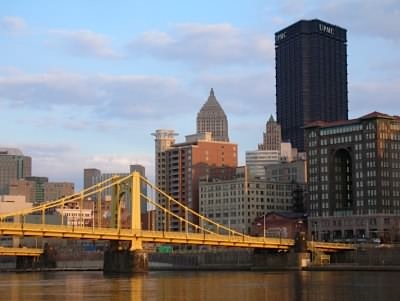
The trails that run alongside are my favorite place to run. Each time I run there, I conjure little dreams of sailing--on the gentle waters under the magnificent spans.
The weather forecast and river currents showed the window for sailing on the river was coming on this Saturday. Then, winds at 9 mph from NNW were forecast; and the plots of the river currents were showing that the flows were now returning to normal after the floods.
We packed ourselved up in the morning for our day. Eve had a 25 mile bike ride planned. I would sail.
Ours is an interesting block downtown. There always seems to be something happening. I steer my bike, laden with sailing gear, onto the street, never sure what I'll find. Last time I stepped into the middle of the gay pride event. This time, there were no rainbow colored shorts. Arrayed outside Planned Parenthood, a hundred feet or so from my front door, was a group of antiabortion protesters. They were flanked by a small group of yellow t-shirt clad Planned Parenthood guides.
It seemed more prudent to walk the bike through this little group; I didn't want to run anyone down. As I passed, they burst into hymns that I presumed were aimed at me. The logic was a little hard to follow. Someone pushing a bike, wearing a lifejacket, with a dangling wind speed gauge is not heading for church.
The ride over the bridges and down the river was encouraging. There was a current on the Allegheny, but it was a slow walk. The winds were steady at about 6 mph, whereever I measured them. That was how it should be. Not too much; not too little; and steady.
Once I arrived at the marina, I began the ritual of rigging the boat. This is an especially easy boat on which to step the mast and then rig. Still, doing all the little bits and pieces took 30 minutes. I spent a little time sponging off dirt and bird droppings. No doubt even Ulysses had to handle such problems in his great journeys, although they eluded Homer's narrative. Then I was in the water, ready to head off. Twigs I'd thrown in the water showed a slow walking pace current. It was nothing too much to fuss with, as long as there is wind. (Allegheny River at Natrona, 14,000 cubit feet per second; Mon at Elizabeth, 2,500 cubic feet per second.)

I set off on a broad reach--that is, the wind is as close to directly behind you as you can get. I was soon passing the familiar landmarks: the West End Bridge, the Science Center with its submarine, Heinz Field, and more. There was not much to do on this point of sail. Since you are being blown with the wind, everything is calm and there is no real sense of movement, until you look back at the bubbling wake and the gash it leaves behind in the water. It was most comfortable to kneel in the middle of the deck. I was much more relaxed, now, feeling in better command of the boat.
It was a warm and sunny day and there were many kayakers on the river. One of the transforming moments in Pittsburgh's river history was when Kayak Pittsburgh started renting kayaks on the Allegheny River at a ramp underneath the 6th Street Bridge. Several kayakers were slowly made their way over to me and began to flank me, something like dolphins around ship at sea.
Once you know the trick, you don't need a speedometer to gauge your speed on the water. You need to learn one conversion factor. How fast are you going if a bit of debris takes one second to pass the length of your hull? For my 12 foot hull, that number is 8.2 miles per hour or 7.1 knots.
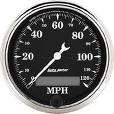
I began counting off my speed. In better breezes, the debris was passing in about 2 seconds; that is, 4 miles per hour.
8.2 mph x 1 sec = 4.1 mph x 2 sec = 2.05 mph x 4 sec
Not bad, but slow. Our big Hobie could attain 20 miles per hour, but that is a very different experience.
In about 30 minutes, I'd arrived at the Point. That seemed about right, given that my dock was 1.25 miles downstream of the Point. There seemed no reason to dock at the Point. The winds were blowing gently but steadily straight upstream. Best just to keep going. So I pointed my bows (there are two on a catamaran!) straight up the Allegheny River. Everything went well until I neared the enormous span of the Duquesne Bridge. Then the wind just seemed to die. I spent an anxious minute with my bows pointed upstream locked in one place, wondering if this was as far as I'd get. Would I be Moses, destined to die in the desert with the promised land in sight?

Then the winds revived. Some 20 minutes after passing the Point I had moored at a dock just upstream of Kayak Pittsburgh, between the 6th and 7th Street Bridges.
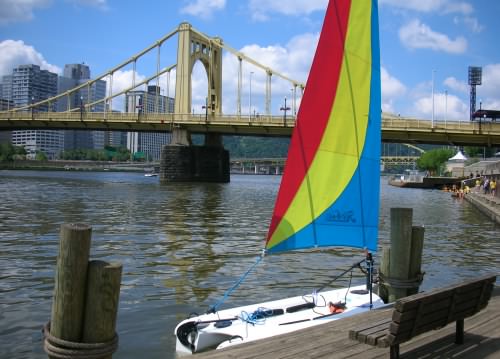
What makes boating so much fun on the rivers is that you get a completely different view of the city. There's nothing quite like seeing one of the magnificent bridges as it passes directly overhead. The many kayakers and this lone sailor this day were having more fun than anyone else in the city.
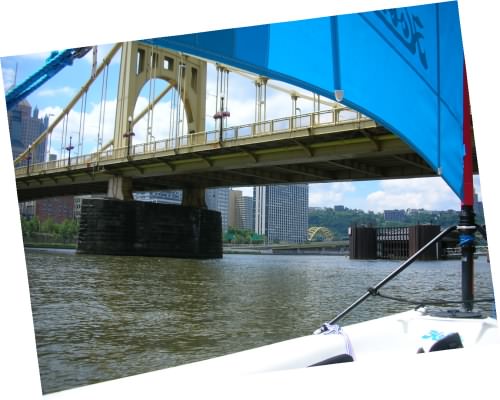
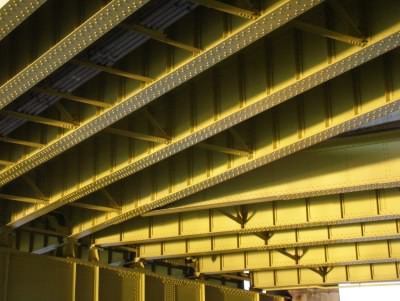
In order to mark the event, my first sail up the Allegheny, I took photos of the boat; and kindly bystanders took photos of me with the boat, with me trying not to look too smug.
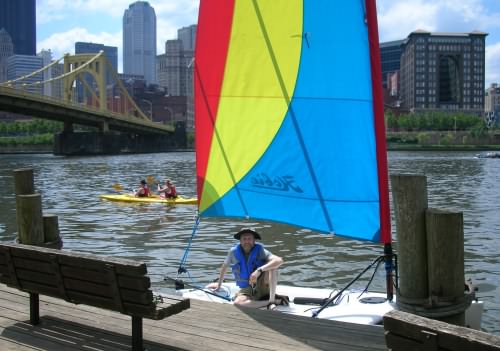
I called Eve to see if her ride was over. This was too much fun for her to miss. After a few missed connections, we arranged for her to ride her bike over. Soon we were both sitting in the boat slicing through the water, directly across the river.
While the wind is steady, it does get deflected by the obstacles in this stretch of the river: bridge pylons, waterfront buildings. So sailing rarely proceeds for long in a straight line.
What now made this little complication more awkward, was the serial appearance of large things. "Keep an eye out for big boats," I said to Eve. No sooner was that said than a big paddle wheel steamer appeared downstream, aimed directly at us. I turned back to the northern side of the river, since the larger boats navigate in channels that seem to lie on the southern sides.
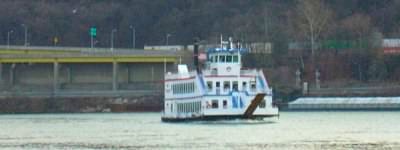
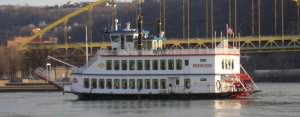
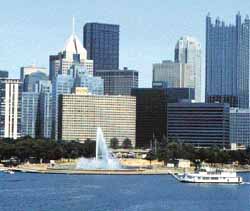
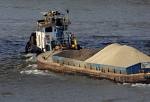
This evasive cycle repeated as first one huge barge and then another decided to share this stretch of the river with us. Of course "share" is not quite the way it works. They arrive, moving fast, and we stay out of their way.
Since Eve's bike was locked up at the 6th Street Bridge, we couldn't go too far afield. So I started the long tack back to the marina, letting Eve off just upstream of the Duquesne Bridge.
The voyage from the marina had been easy. I sailed on a broad reach with the wind behind me. The return would be harder and slower. The wind is blowing directly along the river from downstream, exacly where I'd need to sail. That means tacking back and forth, again and again.
In one regard, it is more fun. With the wind coming obliquely over the bows, the boat moves a lot faster in the water. It's fast and its fun. But in another way, it is slow. You spend your time bouncing like a tennis ball to and fro across the net. At first it seems that you are getting nowhere at all for all the effort. You soon learn to gauge your progress by marking points on the shore. I start ticking them off. On this tack, we are at the conning tower of the submarine. Now--off, across the river and back. We are now in line with that piece of heavy equipment at the casino building site. This is the journey home. It is fast sailing that gains distance in small doses of a few hundred yards at a time.

I forgot to count off the speed, but my sense now is the we easily
made the one second-to-pass-the-hull time. That means we easily made 8
mph.
Sailors: this is a catamaran, so it is
not bound by the usual rule for hull speed, governing ordinary
displacement hulls:
Hull speed (knots)
= 1.34 x Square root (Length at waterline in feet)
That comes out to 3.8 knots = 4.3 mph for a 12 foot boat. That is the
maximum speed an ordinary 12 foot boat can go. Efforts to push it
faster simply create more hydrodynamic forces that pull the hull deeper
into the water. That makes the boat harder to move and defeats efforts
to speed it up. The only escape from this cycle is to use a powerful
enough force to get the boat to hydroplane. Catamarans are free of this
hull speed limit for reasons I don't quite understand. It's something
to do with replacing the bulky monohull with two knifelike catamaran
hulls. In any case, it's a really good reason to sail a catamaran on
the river when there can be currents to beat!
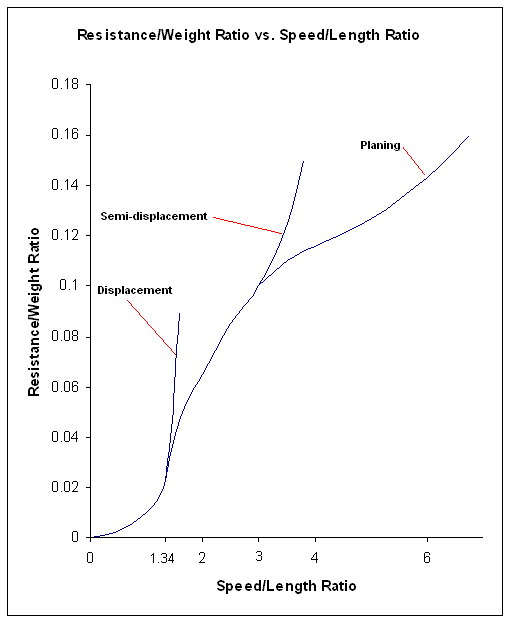
From
http://en.wikipedia.org/wiki/File:Speed-length_vs_weight-resistance.gif
The quantity on the horizontal axis is probably misstated. The
magnitude should be the ratio of speed divided by (square root of
length). That way the usual hull speed rule is recovered when the ratio
is 1.34, the value at which resistance "blows up" for displacement
hulls. My guess is that the horizontal axis is intended to be this
latter ratio. It was the one Froude defined in his 19th century studies
of hull resistance and is commonly called the "speed length ratio."
That doesn't mean it is computed as the ratio of speed/length!
In retrospect, the disasters of my first two sailing days on the river, were not just inhospitable winds and currents. It was also my own ineptitude with the boat. I now knew it much better and could swivel and twist about on the deck with fairly fluid movements, as I moved between the various seating positions needed. The business of tacking into the wind is all about sailing as close to the wind as you can get. I was now better able to judge how close was too close. I'd also learned to leave the sail out as I pointed closer to the wind and only then to haul it in tight; that little trick minimized the chance of an overpowered sail on a beam reach--that is, side on to the wind--tipping the boat.
The journey had taken a little over 30 minutes on a broad reach. It now required about an hour of tacking to go in the opposite direction. After I had pulled into the marina, I noticed that the current had so subsided as to be unnoticeable. I'd gotten no help from it.
I was getting smug. As I approach the marina ramp, I could see a large powerboat in the process of being launched. It had stopped half way down as its sailors fussed with the rudder and screw. I took my moment and brazenly sailed into the ramp's little channel, in full sail, turning at the last moment to beach right where I stored the boat. "Slick," I thought to myself. The powerboat sailors didn't know that they'd just seen a little display sailing machismo. They'd just seen some guy in a sailboat and silly hat go by. They'd chuckle if they heard I thought 8 knots was fast.
In about 20 more minutes, I had the boat out of the water and back on its trailer, the mast down and all the gear stowed. I was back on my bike and cycling home.



Once again, I marvelled at the extraordinary density of downtown living in Pittsburgh. In moments, I'd passed from a sailboat on a quiet green, stretch of the river; along trails, with people walking, running and strolling; past kayakers scooping their way under bridges; past a football stadium and a baseball park, where the strains of the music flowed out onto the riverbank; past the traffic of a full-blown downtown, with restaurants, bars and skyscrapers; past the scene of the morning's demonstration; and into my living room. We were visiting friends for dinner. Still in my sailing gear, I walked to the liquor store, just a few doors away and made my wine selections. I was, at that moment, hard pressed to imagine any city in the world that could match that experience.
John D. Norton
Back to main